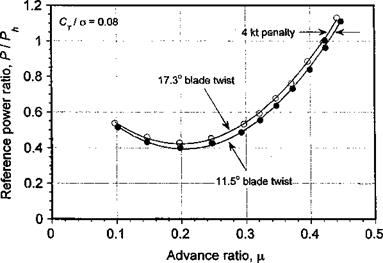Blade Twist
The proper use of blade twist (washout) can significantly improve the figure of merit of the rotor, a result found early on in helicopter development after the development of basic aerodynamic theory. This is reflected in Fig. 6.2 by the significant gain in the FM for the early Sikorsky R-4 helicopter by using redesigned blades with twist. Based on the combined blade element momentum theory (BEMT) discussed in Section 3.3, it has been shown that negative (nose down) twist can redistribute the lift over the blade and help reduce the induced power, but only to a point. Therefore, proper use of blade twist can significantly improve the figure of merit in hover. In Section 3.3.11 the effect of blade twist on the induced power factor has been shown based on analytical results. Paul & Zincone (1977) have shown the effects of blade twist on the maximum figure of merit deduced from full-scale rotor tests; these results are reproduced in Fig. 6.11. In general, the results confirm the theory in that the figure of merit of highly twisted rotors is nearly always better than
4-І* nf +ТТП nfa/4 пгічап nf fUa nnma /4 л olr 1 rv n/4ir» a
uiai iui iwidi^u lvstuia wn^u иртаии^ at tut aauit vxiojv iiiauiiig.
In forward flight, rotors with a high nose-down blade twist (say, greater than 15°) may suffer some performance loss. This is because of the reduced angles of attack can be produced on the tip of the advancing blade, resulting in a loss of rotor thrust and propulsive force. The problem has been explored by Keys et al. (1987). Results documenting the problem are shown in Fig. 6.12 in terms of power required (relative to hover power) versus advance ratio. Although not severe, some degradation in high-speed cruise performance is noted with the higher blade twist. Blades with very large twist rates, while offering performance benefits in hover, may suffer reduced or even negative lift production on the advancing blade tip and are obviously to be avoided. A survey of existing rotor designs
 |
shows that most helicopter blades incorporate a negative linear twist between 8° and 15°, with only a few exceptions. This twist range is a compromise between maximizing the FM of the rotor in hover at its design point (typically maximum hover gross weight), while simultaneously avoiding any detrimental effects on forward flight performance. Clearly, however, some gains in FM are possible if large values of blade twist can be tolerated. In the quest for high-speed forward flight capability of the helicopter, some manufacturers have used a nonlinear twist or double linear blade twist, where the effective twist rate is reduced or reversed near the blade tip. This helps give the helicopter better forward flight
|
Figure 6.12 A loss of performance with highly twisted rotor blades may be expected in forward flight. Data source: Keys et al. (1987). |
performance while retaining most of the hover performance and thus offers another good compromise for the rotor design.












